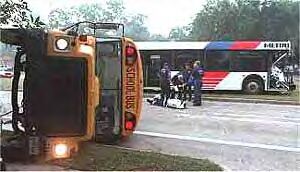
Light Rail Now (LRN) can be contacted at: Light Rail Now! |
Light Rail Now! Website Comparative accident rates of light rail transit (LRT) vs. other
public transport modes have become a political football,
particularly within the USA in local vote campaigns for and against
major LRT initiatives (e.g., Kansas City, Cincinnati, Tucson,
Houston). While fatality rates are often the focus of news reports,
fatalities in public transport are relatively very rare, while injuries
are much more common. in 2000, for example, there were less
than 300 fatalities, but nearly 57,000 injuries, as reported by the
US Department of Transportation (DOT). To attain an adequate and comprehensive perspective on safety in urban public transportation, one must examine both injuries and fatalities. As noted, the number of fatalities is relatively small, but the number of injuries is many times higher. The following graph presents average rates of total injuries and fatalities for all major transit modes and automated guideway transit (AGT) over the 9-year period 1992-2000 (for which complete data were accumulated by US DOT). Bus data are totalled for large, medium, and small motor buses and the demand-responsive bus mode. Regional passenger rail (RPR) refers to regional "heavy" rail operations, commonly called commuter rail. Rail rapid transit (RRT) refers to totally grade-separated, usually elevated or subway rail transit. LRT refers to modern light electric railways, older urban streetcar systems, and rail trolley circulator systems. AGT refers to automatic, driverless systems. These systems are extremely rare, but include such examples as automated peoplemovers in Miami and Detroit and the Jacksonville Skyway monorail. Average Rate of Transit Mode
These averages are derived from the data presented in the table
below. Rates of Transit Mode
From the graph above, it can be seen that, in total fatalities + injuries, the motor bus mode leads in transit accident rate, with an average 2.5 per million passenger-miles over the period 1992-2000. Curiously, automated guideway transit (AGT) has the second-highest rate, with average of 2.0. Light rail transit, with an average of 1.3, appears substantially safer, although its rate is about 30% above that of rail rapid transit. Regional ("commuter") rail has the lowest rate of all these transit modes, with 0.3. On the whole, buses have significantly more total injury + fatality accidents per passenger-mile than LRT or other rail modes. Thus, these data suggest that, in terms of the public's actual potential exposure to an accident, rail transit, including LRT, is substantially safer than bus. Fatality and injury rates per million passenger-miles for these modes are presented separately in the tables below. All these data are calculated from the original US DOT data replicated below. Fatality Rates per Million Passenger-Miles
injury Rates per Million Passenger-Miles
These injury + accident rates per passenger-mile are derived from the accumulated US DOT data presented in the tables below. These figures apparently include suicides. The source of all data is the US DOT: http://transit-safety.volpe.dot.gov/Publications/Default.asp#SAMIS Total Fatalities
Total injuries
Total Passenger-Miles (Millions)
Updated 2003/10/11 | ||||||||||||||||||||||||||||||||||||||||||||||||||||||||||||||||||||||||||||||||||||||||||||||||||||||||||||||||||||||||||||||||||||||||||||||||||||||||||||||||||||||||||||||||||||||||||||||||||||||||||||||||||||||||||||||||||||||||||||||||||||||||||||||||||||||||||||||||||||||||||||||||||||||||||||||||||||||||||||||||||||||||||||||||||||||||||||||||||||||||
|
|
|||||||||||||||||||||||||||||||||||||||||||||||||||||||||||||||||||||||||||||||||||||||||||||||||||||||||||||||||||||||||||||||||||||||||||||||||||||||||||||||||||||||||||||||||||||||||||||||||||||||||||||||||||||||||||||||||||||||||||||||||||||||||||||||||||||||||||||||||||||||||||||||||||||||||||||||||||||||||||||||||||||||||||||||||||||||||||||||||||||||||